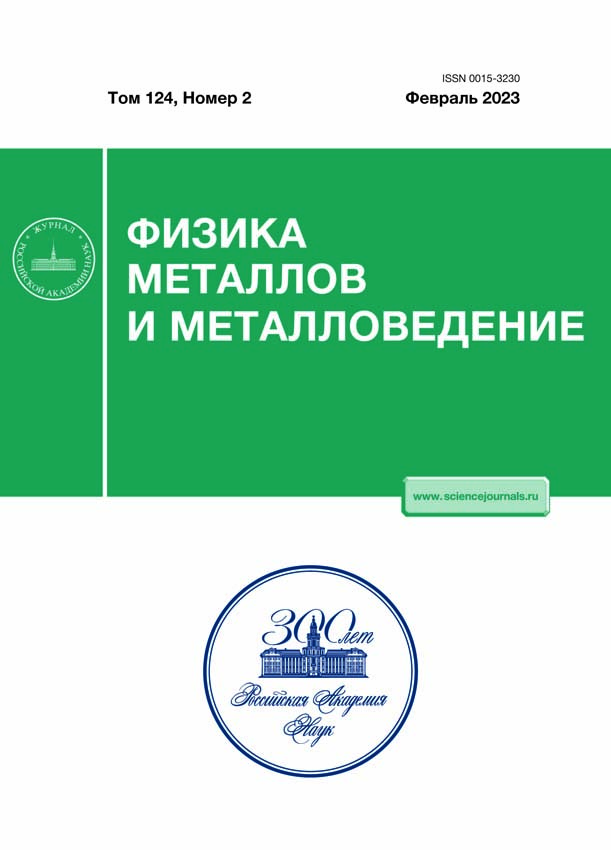The Effect of the Interface Width on the Exchange Interaction Constant between Ferro- and Antiferromagnets
- Authors: Il’yushin I.G.1, Afremov L.L.1, Kharitonov V.N.2
-
Affiliations:
- Department of Theoretical Physics and Intelligent Technologies, Institute of High Technologies and Advanced Materials, Far Eastern Federal University
- Laboratory for Simulation of Physical Processes, Institute of High Technologies and Advanced Materials, Far Eastern Federal University
- Issue: Vol 124, No 2 (2023)
- Pages: 175-181
- Section: ЭЛЕКТРИЧЕСКИЕ И МАГНИТНЫЕ СВОЙСТВА
- URL: https://innoscience.ru/0015-3230/article/view/662806
- DOI: https://doi.org/10.31857/S0015323022601544
- EDN: https://elibrary.ru/KYSHCA
- ID: 662806
Cite item
Abstract
Within the model of two-phase (core/shell) ellipsoidal nanoparticles, the effects of the interfacial exchange interaction, size, elongation, and orientation of the major axes of the core and shell on the meta-stability of magnetic states have been simulated. Using the example of Fe2.44Ti0.56O4 nanoparticles,Fe3O4 it is shown that the metastability of magnetic states is realized in a limited range of the constant of interfacial exchange interaction between the core and shell, Ain , and geometric parameters. With an increase in the absolute value of the interfacial exchange interaction constant, , from Ain = 0 to some finite value, theAin metastability of magnetic states decreases monotonically from maximum to zero, regardless of the angle between the major axes of the core and the shell.
About the authors
I. G. Il’yushin
Department of Theoretical Physics and Intelligent Technologies, Institute of High Technologies and Advanced Materials, Far Eastern Federal University
Email: iliushin.ig@dvfu.ru
Vladivostok, Primorskii Krai, 690922 Russia
L. L. Afremov
Department of Theoretical Physics and Intelligent Technologies, Institute of High Technologies and Advanced Materials, Far Eastern Federal University
Email: iliushin.ig@dvfu.ru
Vladivostok, Primorskii Krai, 690922 Russia
V. N. Kharitonov
Laboratory for Simulation of Physical Processes, Institute of High Technologies and Advanced Materials,Far Eastern Federal University
Author for correspondence.
Email: iliushin.ig@dvfu.ru
Vladivostok, Primorskii Krai, 690922 Russia
References
- Frederix F., Friedt J.M., Choi K.H., Laureyn W., Campitelli A., Mondelaers D., Borghs G. Biosensing based on light absorption of nanoscaled gold and silver particles // Analytical Chemis. 2003. V. 75. P. 6894–6900.
- Andersson P., Forchheimer R., Tehrani P., Berggren M. Printable All-Organic Electrochromic Active-Matrix Displays // Adv. Functional Mater. 2007. V. 17. P. 3074–3082.
- Cahill D.G., Braun P.V., Chen G., Clarke D.R., Fan S., Goodson K.E., Shi L. Nanoscale thermal transport. II. 2003–2012 // Appl. Phys. Rev. 2014. V. 1. P. 011305.
- Saykova D., Saikova S., Mikhlin Y., Panteleeva M., Ivantsov R., Belova E Synthesis and Characterization of Core–Shell Magnetic Nanoparticles NiFe2O4@Au // Metals. 2020. V. 10. P. 1075.
- Nogués J., Sort J., Langlais V., Skumryev V., Suriñach S., Muñoz J.S., Baró M.D Exchange bias in nanostructures // Phys. Reports 2005. V. 422. P. 65–117.
- Afremov L., Anisimov S., Iliushin I. Size effect on the hysteresis characteristics of a system of interacting core/shell nanoparticles // J. Magn. Magn. Mater. 2018. V. 447. P. 88–95.
- Stavn M., Morrish A. Magnetization of a two-component Stoner-Wohlfarth particle // IEEE Transactions on Magnetics. 1979. V. 15. P. 1235–1240.
- Yang J.-S., Chang C.-R. The influence of interfacial on the coercivity of acicular coated particle // J. Appl. Phys. 1991. V. 69. P. 7756–7761.
- Anisimov S., Afremov L., Petrov A. Modeling the effect of temperature and size of core/shell nanoparticles on the exchange bias of a hysteresis loop // J. Magn. Magn. Mater. 2020. V. 500. P. 166 366.
- Афремов Л.Л., Панов А.В. Влияние механических напряжений на остаточную намагниченность насыщения системы наночастиц // ФММ. 2008. Т. 106. № 3. С. 248–256.
- Syono Y. Magnetocrystalline anisotropy and magnetostriction of Fe3O4–Fe2TiO4 series with special application to rock magnetism // Japan. J. Geophys. 1965. V. 4(1). P. 71–143.
Supplementary files













